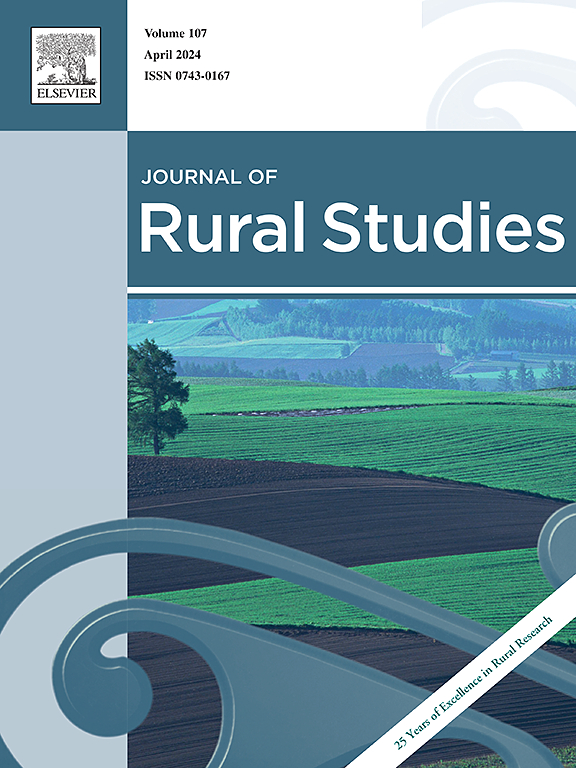What influences the development of wine-producing regions? New economic opportunities in the eastern foothills of the Helan Mountains in China
IF 5.1
1区 社会学
Q1 GEOGRAPHY
引用次数: 0
Abstract
The formation and development of wine regions require unique natural conditions and hundreds of years of technical and cultural accumulation. The development of the wine industry at the eastern foot of Helan Mountain in China, in addition to the appropriate geographical environment, the technical migration, and talent flow supported by consistent policies, have improved the allocation ability of resource factors and conversion efficiency, making it a world-renowned new wine-producing region in just 40 years. This particular mechanism deserves attention as new industries develop in other parts of the world. Using the methods of spatial autocorrelation, hot spot analysis, and geographic detector, this paper comprehensively analyzes the growth and spatial evolution characteristics of wineries in the eastern foot of Helan Mountain in China and deeply discusses the mechanism of the interaction between the localization of global floating capital and China's unique regional economic policies. It is found that the local selection of global floating capital has a spatial locking effect on the formation of CHMWR, and the rolling support policies of China's central and local governments promote the rapid expansion and regional spread of the number and scale of wineries, with significant spatial agglomeration and spatial diffusion. The profound mechanism of such changes lies in the dual interaction of the local selection of global liquid capital and the Chinese government's wine-producing policies adapted to the geographical environment. In this process, a series of internal and external factors such as the innovation of grape planting and wine-making technology, consumer market, and government behavior have accelerated the continuous growth of the wine-producing region at the eastern foot of Helan Mountain in Ningxia. This paper adds a new understanding and deep understanding of the interaction between the local implantation of economic globalization and the macro-control policies of the Chinese government.
是什么影响了葡萄酒产区的发展?中国贺兰山东麓的新经济机遇
葡萄酒产区的形成和发展,需要得天独厚的自然条件和千百年的技术文化积淀。中国贺兰山东麓葡萄酒产业的发展,除了得天独厚的地理环境外,在一贯的政策支持下,技术转移、人才流动,提高了资源要素的配置能力和转换效率,使其在短短的 40 年间成为世界知名的葡萄酒新产区。这一特殊机制值得世界其他地区发展新兴产业时借鉴。本文运用空间自相关、热点分析、地理检测器等方法,全面分析了中国贺兰山东麓葡萄酒庄的成长与空间演化特征,深入探讨了全球流动资本本地化与中国独特区域经济政策的互动机制。研究发现,全球流动资本的本土选择对中国葡萄酒庄的形成具有空间锁定效应,中国中央和地方政府的滚动扶持政策促进了葡萄酒庄数量和规模的快速扩张和区域扩散,具有显著的空间集聚和空间扩散效应。这种变化的深刻机理在于全球流动资本的本土选择与中国政府因地制宜的酿酒政策的双重互动。在这一过程中,葡萄种植与酿造技术创新、消费市场、政府行为等一系列内外因素加速了宁夏贺兰山东麓产区的不断发展。本文对经济全球化在当地的植入与中国政府宏观调控政策之间的互动关系有了新的认识和深刻理解。
本文章由计算机程序翻译,如有差异,请以英文原文为准。
求助全文
约1分钟内获得全文
求助全文
来源期刊

Journal of Rural Studies
Multiple-
CiteScore
9.80
自引率
9.80%
发文量
286
期刊介绍:
The Journal of Rural Studies publishes research articles relating to such rural issues as society, demography, housing, employment, transport, services, land-use, recreation, agriculture and conservation. The focus is on those areas encompassing extensive land-use, with small-scale and diffuse settlement patterns and communities linked into the surrounding landscape and milieux. Particular emphasis will be given to aspects of planning policy and management. The journal is international and interdisciplinary in scope and content.
 求助内容:
求助内容: 应助结果提醒方式:
应助结果提醒方式:


